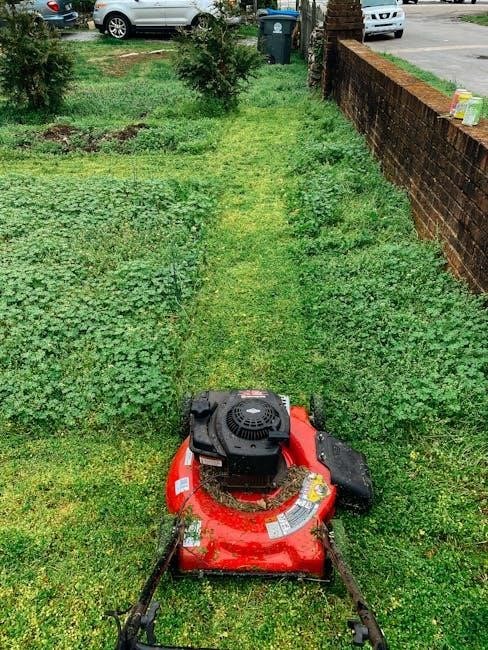Safety Precautions
- Always read the manual thoroughly before operating the mower.
- Wear protective gear, including gloves and eye protection.
- Keep children and pets at a safe distance during operation.
- Ensure the mower is used on stable, level ground.
- Never operate the mower near water or in wet conditions.
1.1 Essential Safety Rules
- Always read and understand the entire manual before operating the mower.
- Wear protective gear, including gloves, safety glasses, and sturdy footwear.
- Ensure the cutting area is free from obstacles, toys, and debris.
- Never operate the mower on uneven or slippery terrain.
- Keep children and pets away from the mower while in use.
- Avoid mowing in extreme weather conditions, such as heavy rain or thunderstorms.
- Always disconnect the spark plug wire before performing maintenance.
- Never tamper with safety devices or bypass protective features.
- Regularly inspect the mower for damage or wear and address issues promptly.
Following these rules ensures safe and effective operation of your Craftsman lawn mower.
1.2 Safe Handling and Operation Guidelines
- Always start the engine on a level surface to prevent tipping.
- Use the correct oil type, such as synthetic 5W30, to ensure proper engine function.
- Never leave the mower unattended while it is running.
- Keep the mower deck clear of debris to maintain even cutting performance.
- Operate the mower at a steady, moderate pace to avoid losing control.
- Ensure all guards and protective covers are securely in place during operation.
- Always turn off the engine and allow it to cool before performing maintenance.
- Use the mower only for its intended purpose and follow the recommended cutting heights.
Proper handling and operation ensure the mower functions safely and efficiently.

Assembly and Installation
Assemble the mower by attaching handles and checking all bolts. Use the provided tools, like a wrench and screwdrivers, to secure parts tightly. Follow the manual for specific assembly steps to ensure proper installation and functionality.
2.1 Step-by-Step Assembly Guide
Begin by unpacking and inventorying all components; Attach the handles using the provided bolts and wrench. Ensure all connections are secure. Next, install the cutting deck by aligning it with the mower base and tightening the screws. Connect the throttle and brake cables to the control panel. Attach the grass bag or discharge chute, depending on your model. Finally, check the blade for proper alignment and tighten it firmly. Refer to the manual for specific torque settings and diagrams to ensure accurate assembly. Double-check all parts for tightness before first use.
2.2 Required Tools and Equipment
To assemble and maintain your Craftsman lawn mower, you will need the following tools and equipment:
- A socket set or wrench for bolt tightening.
- A screwdriver (both Phillips and flathead) for adjusting components.
- Pliers for gripping small parts.
- A torque wrench for precise bolt tightening.
- Gloves and safety goggles for protection.
- A clean, flat work surface for assembly.

Ensure all tools are readily available to streamline the assembly process and maintain safety standards.

Operating Instructions
Follow these guidelines for safe and effective operation: start the engine correctly, use proper mowing techniques, and adjust the cutting deck as needed for optimal results.
3.1 Starting and Stopping the Engine
To start the engine, ensure the mower is on a level surface and the parking brake is engaged. Prime the engine if it’s cold, then move the choke to the “start” position. Pull the starter cord firmly until the engine roars to life. Once running, gradually move the choke to the “run” position. For stopping, reduce the throttle to the lowest setting and allow the mower to cool slightly. Engage the ignition switch to the “off” position and ensure the blade stops completely before leaving the mower unattended.
3.2 Mowing Techniques and Patterns
For optimal results, start by mowing in straight, overlapping lines, turning at the end of each pass. Maintain a consistent mowing height and overlap each previous swath slightly. Circular patterns are ideal for small areas, while spiral patterns work best for larger lawns. Always mow in the same direction as the grass grows to avoid tearing; If mowing tall grass, raise the deck height to prevent clogging. Turn the mower off before reversing or changing direction. Regularly check for even cutting and adjust your technique as needed to ensure a uniform appearance across your lawn.
3.4 Adjusting the Cutting Deck Height
To achieve an even cut, adjust the cutting deck height according to your lawn’s needs. Locate the height adjustment levers or knobs on both sides of the mower. Move the levers to the desired position, ensuring the deck is level. For most grass types, a height of 2.5–3 inches is recommended. Use the reference marks on the levers to maintain consistency across all four wheels. After adjusting, test the height by placing the mower on a flat surface and measuring from the ground to the cutting deck. Proper adjustment ensures a clean, even cut and prevents damage to the lawn or mower. Always refer to the manual for specific height recommendations for your mower model.

Maintenance and Care
- Regularly inspect and clean the mower deck to prevent debris buildup.
- Sharpen or replace the blade annually for optimal cutting performance.
- Change the oil as recommended to maintain engine health.
- Check and replace the air filter to ensure proper engine function.
- Store the mower in a dry, protected area during the off-season.
4.1 Routine Maintenance Schedule
To ensure optimal performance, follow this maintenance schedule:
- Daily: Check oil levels, tire pressure, and blade condition before use.
- Weekly: Inspect and clean the mower deck to prevent debris buildup.
- Every 50 Hours: Change the engine oil and sharpen the blade.
- Monthly: Replace the air filter and inspect spark plugs.
- Annually: Lubricate moving parts, check belts, and replace worn components.
Adhering to this schedule ensures longevity and efficiency of your Craftsman lawn mower.
4.2 Oil Change and Lubrication Guidelines
Regular oil changes and proper lubrication are crucial for maintaining your Craftsman lawn mower’s performance and longevity.
- Use synthetic 5W30 or SAE 30 oil with API SF-SJ classification for optimal engine protection.
- Drain old oil into a drip pan, then refill with the recommended oil type.
- Check for leaks after refilling and ensure the oil filter is securely tightened.
- Lubricate moving parts, such as wheel axles and cable ends, with lithium-based grease.
- Refer to your manual for specific oil capacity and lubrication points.
Perform these steps every 50 hours of operation to keep your mower running smoothly.
4.3 Blade Sharpening and Replacement
Sharpening and replacing the blade ensures clean cuts and extends mower life. Always disconnect the spark plug before servicing.
- Sharpen the blade using a file or grinder, maintaining the original angle and balance.
- Inspect for wear or damage; replace if bent or excessively worn.
- Use a torque wrench to secure the new blade tightly.
- Check blade balance after installation to prevent vibration.
Refer to your manual for specific blade replacement instructions and torque specifications.
4.4 Cleaning the Mower Deck and Undercarriage
Regular cleaning of the mower deck and undercarriage prevents grass buildup and rust. Disconnect the spark plug for safety before starting.
- Use a wire brush or garden hose to remove debris from the deck.
- Inspect for rust or damage and treat or replace parts as needed.
- Apply a rust-inhibiting spray to protect metal surfaces.
- Allow the mower to dry completely before storing.
Regular cleaning ensures optimal performance and extends the lifespan of your mower.

Troubleshooting Common Issues
For diagnosing engine issues, inspect the spark plug and fuel system. For cutting problems, check blade sharpness and deck alignment. For mobility issues, examine the drive system.
5.1 Diagnosing Engine Problems

Engine issues can often be resolved by checking basic components. Ensure the oil level is adequate and the correct oil type is used, such as synthetic 5W30 or SAE 30. Inspect the spark plug for cleanliness and proper connection. A faulty spark plug may prevent the engine from starting. Additionally, check the fuel filter for blockages and ensure the fuel tank is not empty. Airflow issues can also cause engine problems, so clean or replace the air filter if necessary. If problems persist, consult the official Craftsman manual or contact customer support for further assistance.
5.2 Resolving Cutting Issues
Common cutting issues can often be resolved by checking the blade condition and deck setup. Ensure the mower blade is sharp, as a dull blade can leave uneven cuts. If the blade is damaged, replace it immediately. Check the cutting deck height adjustment to ensure it is set correctly for your lawn type. Uneven tire pressure can also cause poor cutting performance, so verify that all tires are inflated to the recommended levels. Additionally, clear any debris from the mower deck and ensure proper airflow for consistent cutting results. Refer to your manual for specific guidance on addressing these issues effectively.
5.3 Addressing Steering and Mobility Problems
If your Craftsman lawn mower experiences steering or mobility issues, start by checking tire pressure and ensuring all tires are evenly inflated. Clean the mower deck and undercarriage to remove debris that might obstruct movement. Lubricate the wheel axles and steering components as outlined in the manual. If the issue persists, inspect for loose or damaged parts, such as belts or pulleys, and tighten or replace them as needed. For models with hydrostatic transmission, refer to the troubleshooting section for specific guidance. Always consult the manual or contact Craftsman support for assistance with complex mechanical problems.

Storage and Disposal
Drain fuel or use a stabilizer to prevent degradation. Change oil and dispose of it properly. Clean and sharpen the blade, and rinse the mower deck. Store in a dry, protected area; For disposal, recycle old parts responsibly, ensuring hazardous materials are handled correctly. Refer to local guidelines for appropriate disposal methods. Always follow environmental regulations to safely discard mower components.
6.1 Proper Winter Storage Techniques
Before storing your Craftsman lawn mower for winter, ensure it is properly prepared to maintain its condition. Drain the fuel tank or add a fuel stabilizer to prevent degradation. Change the oil and filter to avoid contamination. Clean the mower deck and undercarriage to remove debris. Sharpen the blade and apply a rust-resistant coating. Store the mower in a dry, protected area, such as a garage or shed, away from direct sunlight and moisture. Elevate the mower to protect the wheels and undercarriage. Regularly inspect the storage area to ensure no pests or damage occur during the winter months.
6.2 Safe Disposal of Old Mower Parts
When disposing of old mower parts, prioritize environmental and safety guidelines. Drain all fluids, such as oil and gasoline, and dispose of them at an authorized hazardous waste facility. Remove batteries and recycle them according to local regulations. Sharp components like blades should be wrapped securely to prevent injury. Check local laws for specific instructions on disposing of metal and plastic parts. Consider recycling options for reusable materials. Contact local waste management or Craftsman customer support for guidance on proper disposal methods. Ensure all parts are handled responsibly to minimize environmental impact and adhere to safety standards.

Warranty and Support
Craftsman offers comprehensive warranty coverage for its lawnmowers. Contact customer support at 1-800-659-5917 for assistance. Visit the official website for detailed warranty information and online resources.
7.1 Understanding Your Warranty Coverage
Your Craftsman lawn mower is backed by a comprehensive warranty program. Coverage varies by model but typically includes parts and labor for defects in materials and workmanship. The warranty period generally ranges from 2 to 5 years, depending on the product and usage. Register your mower on the official Craftsman website to ensure warranty validity. Review the manual for specific terms and conditions. Warranty coverage may exclude normal wear, improper maintenance, or misuse. For detailed information, refer to the warranty section in your manual or contact Craftsman customer support.
7.2 Contacting Craftsman Customer Support
For assistance with your Craftsman lawn mower, contact customer support at 1-800-659-5917. Visit the official Craftsman website for online resources, including manuals and troubleshooting guides. Additionally, online forums and communities provide peer-to-peer support for common issues. Register your product on the Craftsman website to access exclusive support services. For detailed inquiries, refer to the manual or the Craftsman Help Line for personalized assistance.

Additional Resources
Visit Manua.ls for 61 Craftsman manuals, including popular models like CMXGRAM1130035. Online forums and communities offer peer support for troubleshooting and maintenance tips.
8.1 Official Craftsman Manuals and Guides
Access official Craftsman manuals and guides on Manua.ls, featuring detailed instructions for models like CMXGRAM1130035 and CMCMW220P2. These resources include operation, maintenance, and repair guidelines, ensuring optimal performance of your lawnmower. Download PDF versions for easy reference, covering safety precautions, assembly steps, and troubleshooting tips. Additionally, Craftsman provides comprehensive support through their official website, offering specific model information and customer assistance. Utilize these resources to maintain your equipment effectively and address any issues promptly.
8.2 Online Forums and Community Support
Engage with online forums and communities dedicated to Craftsman products for peer-to-peer support and shared experiences. Platforms like Manua.ls and specialized lawnmower forums offer discussions on troubleshooting, maintenance tips, and model-specific advice. Users can ask questions, share solutions, and access collective knowledge from experienced Craftsman owners. These communities often provide real-world insights and workarounds, complementing official resources. Participating in these forums can enhance your understanding and help resolve issues efficiently, fostering a supportive environment for all Craftsman product users.
